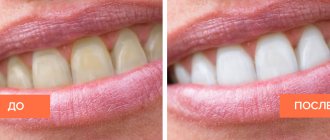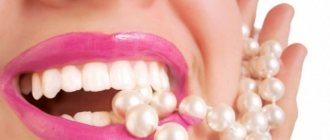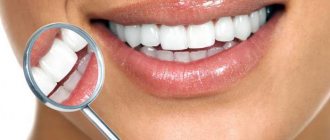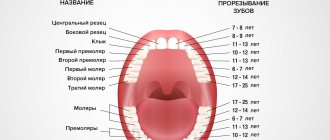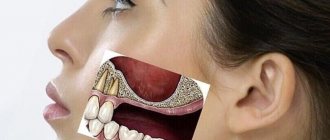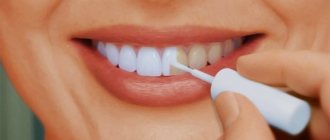- How peroxides whiten dentin
- Hydrogen peroxide
- Urea peroxide
- Where are peroxides found?
- Side effects
Sometimes, to restore whiteness to teeth, you can just remove pigmented plaque from the enamel. If this is not enough, and you are not satisfied with the result, you need to change the natural color of your teeth. This requires dentin bleaching. The fact is that the enamel itself is translucent, and the color of teeth mainly depends on the color of dentin - the hard tissue of the tooth that makes up its main part.
Professional and home whitening products widely use hydrogen and carbamide peroxides. Peroxides are complex substances in which oxygen atoms are connected to each other by single bonds (in other substances by double bonds). Such a connection is easier to break. In addition, in peroxides, oxygen has an oxidation state of “-1” instead of “-2” - that is, it is active during elimination.
How peroxides whiten dentin
Hydrogen peroxide
Hydrogen peroxide molecules easily penetrate the enamel, releasing active oxygen and oxidizing pigmented dentin. It brightens and, shining through the enamel, makes teeth visually whiter.
Urea peroxide
Carbamide peroxide whitens teeth according to the same principle: when it breaks down, hydrogen peroxide is formed, which gives the desired effect. But the reaction rate of carbamide peroxide is lower. Therefore, the impact on the teeth should be longer. However, the mucous membrane is less irritated. If you have sensitive gums, choose products with carbamide peroxide.
Advantages and disadvantages
The method has both advantages and some disadvantages. Benefits include :
- Availability.
- Efficiency.
Among the disadvantages are:
- The presence of a large number of contraindications.
- High probability of enamel injury.
Contraindications
The use of this drug is contraindicated in the following cases :
- Diseases of the oral cavity occurring in the acute stage.
- Caries, periodontal disease.
- Presence of braces or other orthodontic systems.
- Weak enamel.
- Age up to 12 years.
In the absence of the listed contraindications, it is still advisable to consult a dentist and carry out the procedure only with his consent.
Where are peroxides found?
Carbamide peroxide and hydrogen peroxide are found in popular whitening products:
- in whitening strips;
- in gels for use with mouth guards;
- in applicator pencils;
- in some toothpastes.
When choosing a product, pay attention to the concentration of peroxides. From 10% carbamide peroxide, when it decomposes, 3% hydrogen peroxide is released, therefore the concentration of carbamide peroxide in the bleaching product is always higher. Roughly speaking, a gel with 10% carbamide peroxide is as effective as a gel with 3% hydrogen peroxide.
Hydrogen peroxide - what is this substance?
Hydrogen peroxide, or peroxide, is a colorless liquid with a faint metallic taste. The substance is used as an antiseptic - oxygen molecules destroy any infection. Having a cleansing and disinfecting effect, peroxide does not accelerate wound healing. When disinfecting cuts or abrasions, tissue cells are damaged, which prolongs the regeneration period and leads to the formation of scars on the skin.
Due to its oxidizing properties, the liquid is used as a bleach in the textile and pulp and paper industries and as a catalyst in chemical production.
A highly concentrated solution when taken orally causes burns to the mucous membranes, respiratory tract and even death!
Interesting!
Hydrogen peroxide in aquariums is used to “revive” fish. During long-term transportation, the aquarium overheats or the filtering equipment is turned off, the fish experience oxygen starvation and suffocate. Adding a few drops of the substance per liter of water will bring them back to life.
Side effects
Products containing hydrogen peroxide and carbamide peroxide may cause side effects:
- weakening of tooth enamel;
- increased tooth sensitivity;
- irritation of the gum mucosa.
If you use whitening products strictly following the instructions and take care to strengthen the enamel, the risk of side effects is minimal.
Important
. Do not use pharmaceutical peroxide in bottles for whitening - it will leave burns on the mucous membrane and damage the enamel. Use only professional, balanced products - as a rule, they have passed many tests and are safe for the oral cavity.
Teeth whitening methods
With the help of berries
Berries, in particular strawberries and wild strawberries, can not only be eaten, added to a pie or made into jam, but also used to whiten teeth. Both the juice and pulp of strawberries or strawberries can be used as a bleaching material. You need to rinse your mouth with the juice and then rub your teeth with the pulp.
Pros: An environmentally friendly and quite tasty way to whiten your teeth at home.
Disadvantages: however, do not forget that the juice of strawberries and wild strawberries contains acid, which corrodes the enamel of the teeth, so after this method of whitening you need to brush them with toothpaste.
Using an infusion of birch leaves
Pour boiling water over half a glass of birch leaves and let it brew for 20-25 minutes. At least 2 times a day, using a toothbrush soaked in this infusion, brush your teeth for 3 minutes.
Pros: environmentally friendly, completely free and easily accessible way to whiten your teeth at home.
Cons: the infusion contains substances that corrode tooth enamel, so after brushing you must rinse your mouth with water. In addition, whitening will not happen too quickly: the effect will be noticeable in a month at best.
Whitening with soda
You can rub your teeth with a cotton swab dipped in baking soda. You can also fill gauze with it and rub your teeth with a gauze swab - since the surface of the swab will be rough, the cleansing effect will be better. In addition, you can also rinse your mouth with baking soda.
Pros: teeth whitening this way will soon give quite noticeable results, in addition, this method is not at all expensive.
Cons: it is important to know that soda corrodes and thins the enamel of teeth, so frequent whitening with it will be very dangerous. Also, soda has a bad effect on the mucous membranes of the oral cavity and reduces acidity.
Using tree resin
You need to brush your teeth with it using a brush. Potassium hydroxide contained in the resin will promote bleaching.
Pros: environmentally friendly material that will help whiten your teeth at home quite quickly.
Cons: Tree resin cannot be used frequently. With prolonged use, it can damage the enamel and gums.
Whitening with activated carbon
Mash the activated carbon thoroughly to form a powder and apply to a wet brush. Whiten for 2-3 minutes, then rinse your mouth and brush your teeth again, this time with toothpaste.
Pros: this teeth whitening system is easily accessible, because activated carbon is available in any pharmacy and is quite inexpensive.
Cons: this method is not suitable for those who set out to whiten their teeth in the shortest possible time. In addition, if the activated carbon is not crushed well enough, you risk scratching your teeth enamel.
Using whitening pastes
This is the least hassle-free way to whiten your teeth at home. There is no need to grind, rub or insist on anything: just apply the whitening paste to the brush and clean the surface of the teeth. Your dentist will help you decide on the choice of whitening paste.
Electric toothbrushes are more effective than manual ones
Pros: Teeth whitening methods that use whitening pastes are the safest for tooth enamel.
Disadvantages: this is an ineffective method, and this type of whitening cannot be used for more than one month, otherwise the tooth enamel will begin to deteriorate.
Whitening gels
This is a relatively new method that will help whiten your teeth at home. To use it, consultation or assistance from a dentist is required. The doctor will help you choose the right gel and tell you how to use it for whitening. The gel can be simply applied to the surface of the teeth, or it can be whitened using a special tray, which the doctor will make from an impression taken from your own teeth.
Pros: the method is quite effective, giving visible results.
Cons: When using whitening with a tray, you need to be careful with hydrogen peroxide. It is best to carry out such whitening after consultation with a dentist.
Indications for use
The composition copes well with surface contaminants. In the field of dentistry and hygiene, its use is prescribed in the following cases:
- intensive formation of soft plaque due to insufficient hygiene,
- yellowing due to constant smoking,
- frequent consumption of coffee, chocolate and other coloring products with intense pigments,
- yellowing of teeth as a result of age-related changes in the body.
The product will help cope with plaque on the teeth.
If dentin naturally has a slightly grayish or yellowish tint, it will not be possible to achieve whiteness using peroxide alone. The same applies to darkened teeth after depulpation, that is, removal of the nerve. In the latter case, the only option for solving the aesthetic problem will be endobleaching, that is, intracanal bleaching.
How to bleach things at home: traditional methods
In every housewife's arsenal there will probably be such a household chemical item as bleach. There are different types of bleaches, so read the instructions carefully. We list the most popular and widespread means for removing stains from white things.
Chlorine bleaches
The most popular brands are “Belizna” and “Ace”.
The main component of “Whiteness” is active chlorine. This is what removes stains and whitens the material. In addition to chlorine, Belizna may contain surfactants that enhance the effect of the product. Using “Whiteness” you can bleach only cotton and linen items. Silk, wool, and synthetics will not tolerate washing with “Whiteness”. And before bleaching cotton and linen fabrics, you should carefully read the instructions and follow the exact dosage. Otherwise, things will quickly wear out and become unusable.
Whiteness perfectly whitens dense fabrics
“Whiteness” is used only for hand washing! Do not add the product to the washing machine!
Use “Whiteness” depending on what result you plan to see after washing. If you want to maintain the white color or update it, rid things of yellowness, do the following:
- In 10 liters of cool water, dilute 2 tbsp. l. Whiteness.
- Soak the laundry for 20 minutes. Soak the laundry for 1 hour if you want to remove the yellowness and return the original color.
- Rinse the laundry thoroughly.
- Wash it.
If you need to remove a stain from thick fabric, for example, from a bedspread:
- Apply Whiteness to the stain.
- Hold for one minute.
- Soak the item with washing powder for 4–5 hours.
- Rinse.
- Wash it.
When working with Belizna, take precautions: wear gloves, avoid contact with eyes and respiratory tract.
By the way, “Belizna” retains its cleaning properties for six months and cannot be stored in the cold. Use the opened bottle within 6 months and store in a dark, warm place.
Oxygen bleaches
Oxygen bleaches are less aggressive than chlorine bleaches. The active ingredients in their composition are hydrogen peroxide and sodium percarbonate. Surfactants and conditioner can also be added to the bleach. Therefore, as a rule, oxygen bleaches are produced in liquid form. But there are also powder products. Brands of oxygen bleaches:
- Shabondama;
- EcO2;
- Vanish;
- Persol Extra;
- Ace Oxi;
- Clax Sonril conc 40A1;
- Ecover;
- BOS Plus and others.
Oxygen bleaches can be used for hand washing and machine washing. Bleaching agents of this type are intended for both white and colored laundry.
If you machine wash, add oxygen bleach and laundry detergent into the dispenser. Calculate the portion according to the instructions.
For hand washing, we recommend soaking with bleach. Also see the instructions for the product for soaking time.
Optical brighteners
Optical brighteners are not represented by any separate products. They are included in washing powders and stain removers. The principle of their action is tinting. That is, the spots do not disappear anywhere, but are simply painted over with fluorescent paints.
When choosing bleach, carefully read the instructions, which should indicate the types of fabrics for which they are intended. Remember that chlorine bleaches should not be used when washing delicate fabrics.
Pros and cons of peroxide for enamel
To understand and compare the main advantages and disadvantages of at-home peroxide whitening, take a look at the table below.
| pros | Minuses |
| Convenient - no need to visit the doctor's office | Before starting, be sure to consult a specialist |
| You can lighten the enamel by 1-2 tones and restore the natural whiteness of your smile | There are contraindications: thin enamel, its hypersensitivity, diseases of the teeth and gums, pregnancy, lactation and childhood |
| Peroxide additionally disinfects tissues and prevents intense plaque formation | There is a risk of damaging hard tissues or burning the mucous membrane if the technique is not followed. |
Before you decide to have your teeth whitened, go through the procedure by Prof. hygiene. As part of this preventative measure, the specialist will remove plaque and hardened deposits, as a result of which the enamel will return to its natural whiteness. Perhaps this effect will be quite sufficient, and then you will not have to look for a suitable method of whitening yourself.
If a noticeable result is important to you, it is better to contact the dentist. If it is not possible to attend sessions in a clinic, a specialist will select the most suitable home whitening option for you - effective and safe for your specific case.
When to use the solution is contraindicated
Not everyone can use the dental solution. This is why you should first visit your dentist and get his consent. In the following conditions, such measures are contraindicated:
- the presence of untreated carious cavities in the mouth,
- acute forms of gingivitis and periodontitis,
- the presence of old fillings and crowns that require replacement,
- stomatitis, pharyngitis - whitening can be started only after complete recovery.
The solution may contribute to the further spread of caries if there are unhealed holes in the mouth at the time of the procedure. In any inflammatory process, the substance will corrode the affected areas, which will only worsen the situation. Before starting the course, you must replace all old fillings. Otherwise, when the filling becomes depressurized, the solution can easily penetrate into the space between it and the tooth, and this will cause inflammation.
The procedure is not recommended for periodontitis
The composition should not be used during orthodontic correction if the mouth has braces. Individual structural elements may slightly injure the enamel, but when these areas come into contact with peroxide, the pathological process will only intensify. The product should not be used during pregnancy and breastfeeding, in childhood, with thinning enamel and hyperesthesia.
Contraindications
Using any means to whiten tooth enamel can either help or harm. Before you start using them, you should consult with your dentist and take into account the characteristics of your oral cavity.
There are a number of contraindications for using cleaning and whitening teeth with soda, peroxide and lemon. These include:
- Bleeding gums, periodontal disease.
- Presence of oral diseases.
- Thin enamel - soda with abrasive particles erases its top layer.
Advice. To achieve the desired effect when whitening your teeth, you should remember that their natural color is slightly yellowish. You shouldn’t go against nature and make it unnaturally snow-white. This is fraught with further dental problems. Once visible results are achieved, use whitening methods no more than once every two to three months.
Remember - it is easier to destroy than to build. Love yourself and take care of your teeth!
Bringing whiteness back to underwear
Underwear is usually made from delicate types of fabric, which means it requires special care. When working with it, we perform the following actions:
- We fill a basin with water at room temperature.
- Add 3 tablespoons of peroxide and stir.
- Soak the laundry for 30 minutes.
- We rinse the T-shirts and shorts well and send them to dry.
Tulle and organza can also be bleached with peroxide. To do this, they are soaked in water with the addition of a product, and then washed in the usual way.
What effect can be achieved and when to expect it?
We figured out whether peroxide helps whiten teeth, and found out that the substance in low concentration can only provide preventive cleansing of plaque. To achieve a pronounced effect, you cannot do without the help of professionals. Therefore, systematic use of the product at home can provide only slight lightening - by 1-2 tones. The result will appear after 5-7 days. But be careful, because in attempts to achieve a more noticeable effect, you can lose control and start using peroxide too often, and this is fraught with severe thinning of the enamel, the development of hyperesthesia and carious processes.
You can repeat home whitening courses using soda, peroxide or lemon juice no more than 4 times a year. In addition, before starting, you should definitely visit the dentist and make sure that the enamel is completely healthy and there are no contraindications to the use of whitening agents.
